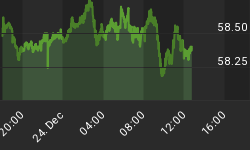Professor Piggington, a.k.a. my good friend Rich Toscano, recently teamed up with a San Diego money management shop called Pacific Capital Associates. Their new website features a well-reasoned explanation of why "cash" is no longer a risk-free investment, and Rich has kindly given permission for the article to appear here. Great job as usual, Rich.
Cash -- Not as Safe as It Seems
Holders of cash and its equivalents (CDs, T-bills, and the like) may not earn much in the way of interest, but they are at least certain to get all of their principal back. For this reason, many people assume that holding all cash is the safest and most conservative possible investment stance.
But there is a hidden threat to cash holders: while they are assured of getting all their money back, the money they get may be worth less than it was when they first deposited it. This is what's known as "purchasing power risk."
We believe purchasing power risk to be a serious issue for today's cautious investors. Our concern is owed to a strongly-held belief that the value of the US dollar is likely to decline substantially in the not-too-distant future. This is a topic that we will revisit in far greater detail down the road, but for now we offer this brief synopsis of our reasoning:
1. Many of our trading partners are purposefully boosting the value of the dollar in order to strengthen export-sector employment. At some point, the political benefits to this policy will be outweighed by the costs, at which time the artificial dollar support will gradually be removed.
2. As the deteriorating housing market begins to affect the general economy, federal policymakers will respond in the usual manner: the Federal Reserve will lower interest rates and the government will step up stimulatory deficit spending. Both policies will result in more debt, higher inflation, and a weaker dollar.
3. We as a nation owe a staggering amount of debt to foreign lenders, all of it denominated in US dollars. Policymakers are almost assured to encourage a decline in the dollar in order to lessen the real burden of our foreign debt.
These macroeconomic forces will exert enormous pressure on the US dollar in the years ahead. As a result, the interest earned by holders of cash-equivalents is unlikely to compensate them for the eventual loss of the dollar's purchasing power.
So what's a conservative saver to do?
The best way to mitigate purchasing power risk is to invest a portion of your money into instruments that will keep their real value, or better yet increase in value, should the dollar lose purchasing power.
There are a few categories of investments that fit the bill. Generally speaking, buying stocks at good values provides decent inflation protection, because over time, the stocks' earnings should grow to offset a decline in the currency in which those earnings are denominated. However, it is important to buy into companies that are not only reasonably priced but that will do well in the coming economic climate (unlike, for instance, many US financial companies that seem cheap but have unacceptably high exposure to the mortgage lending business).
Foreign stocks are especially appealing, both because it's easier to find good values worldwide and because owning foreign companies provides another layer of protection against a dollar decline.
Then there are more direct hedges against a dollar decline. Foreign bonds will rise in value as the dollar declines and will pay interest while you wait. But because it's likely that other currencies will decline along with the dollar, it's also advisable to invest in hard assets, such as precious metals or commodities, or in the companies that produce them.
Many of these investments could be extremely profitable in the face of declining US dollar purchasing power, but could still be expected to do reasonably well even if the dollar decline took longer or was of a lesser degree than expected.
Our advice to those whose main goal is to keep their money safe is this: keep a healthy share of your holdings in cash-equivalents, but also put aside a portion to invest in a diversified portfolio of the dollar-hedging investments described above. The cash share of your holdings will provide you with liquidity and stability of principal, while the investment portion should rise enough to offset any loss of overall purchasing power.
















